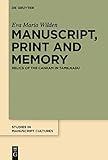Manuscript, Print and Memory : Relics of the Cankam in Tamilnadu / Eva Maria Wilden.
Material type: TextSeries: Studies in Manuscript Cultures ; 3Publisher: Berlin ; Boston : De Gruyter, [2014]Copyright date: ©2014Description: 1 online resource (445 p.)Content type:
TextSeries: Studies in Manuscript Cultures ; 3Publisher: Berlin ; Boston : De Gruyter, [2014]Copyright date: ©2014Description: 1 online resource (445 p.)Content type: - 9783110340891
- 9783110387797
- 9783110352764
- 894.8/1109 23
- PL4758.05 .W54 2015
- online - DeGruyter
- Issued also in print.
| Item type | Current library | Call number | URL | Status | Notes | Barcode | |
|---|---|---|---|---|---|---|---|
 eBook
eBook
|
Biblioteca "Angelicum" Pont. Univ. S.Tommaso d'Aquino Nuvola online | online - DeGruyter (Browse shelf(Opens below)) | Online access | Not for loan (Accesso limitato) | Accesso per gli utenti autorizzati / Access for authorized users | (dgr)9783110352764 |
Frontmatter -- Preface -- List of Abbreviations -- Contents -- I. Introduction -- II. The Manuscripts -- III. Transmissional History -- III.1 The Invocation Stanzas (kaṭavuḷ vāḻttu) -- III.2 Traditional Colophons -- III.3 Mnemonic Stanzas -- III.4 The Caṅkam Legends -- III. 5 Reception in the Grammatical Tradition -- III.6 Summary: The Rise and Fall of a Canon -- IV The Editing Process -- V Conclusion: The Restitution of a Canon -- Literature -- List of Acknowledgements for the Illustrations -- Index
restricted access online access with authorization star
http://purl.org/coar/access_right/c_16ec
The ancient Tamil poetic corpus of the CaM49;am ("The Academy") is a national treasure for Tamilians and a battle-ground for linguists and historians of politics, culture and literature. Going back to oral predecessors probably dating back to the beginning of the first millennium, it has had an extremely rich and variegated history. Collected into anthologies and endowed with literary theories and voluminous commentaries, it became the centre-piece of the Tamil literary canon, associated with the royal court of the Pandya dynasty in Madurai. Its decline began in the late middle ages, and by the late 17th century it had fallen into near oblivion, before being rediscovered at the beginning of the print era. The present study traces the complex historical process of its transmission over some 2000 years, using and documenting a wide range of sources, in particular surviving manuscripts, the early prints, the commentaries of the literary and grammatical traditions and a vast range of later literature that creates a web of inter-textual references and "ations.
Issued also in print.
Mode of access: Internet via World Wide Web.
In English.
Description based on online resource; title from PDF title page (publisher's Web site, viewed 28. Feb 2023)


